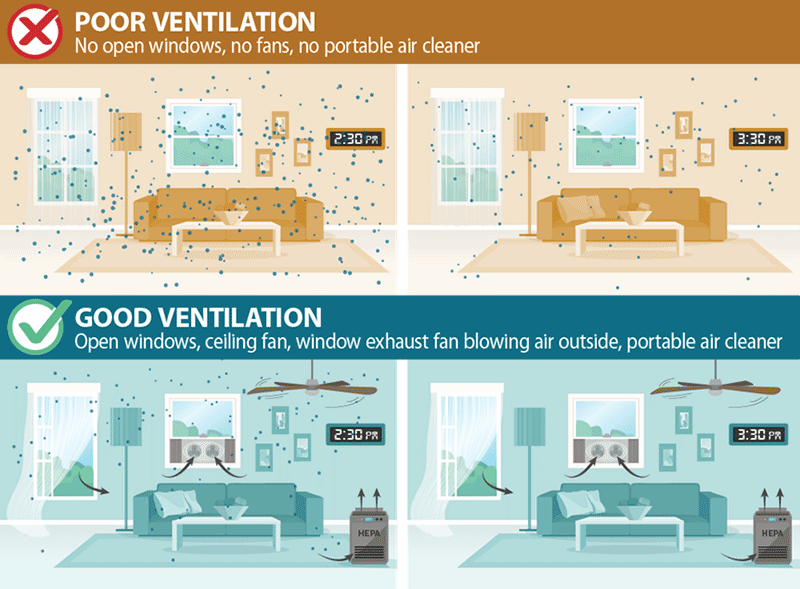Recognizing the Significance of Home Air Flow for a Healthier Living Environment
Home ventilation plays a vital duty in preserving a healthy and balanced living environment. It facilitates the exchange of outdoor and indoor air, which is necessary for boosting air high quality. Without correct ventilation, homes can become reproducing premises for toxins and irritants. The effects of insufficient air blood circulation can be substantial. This raises the questions of just how house owners can effectively execute ventilation methods to secure their wellness and wellness. Understanding these techniques is vital.

The Essentials of Home Air Flow
Home ventilation acts as an important component of interior air high quality and convenience. It includes the process of trading stale indoor air with fresh outside air, thus minimizing moisture and regulating temperature. Correct air flow systems can include natural methods, such as open windows and vents, in addition to mechanical systems, such as exhaust fans and air exchangers. Effective home air flow helps prevent problems like indoor mold and mildew development and the accumulation of harmful fragments. It additionally improves general energy efficiency, as well-ventilated spaces can keep comfy temperature levels with much less dependence on home heating and cooling systems. Comprehending the basics of home air flow is crucial for property owners seeking to create a much healthier living setting on their own and their families.

Common Resources of Indoor Air Pollution

Several might not recognize it, interior air pollution can originate from various sources within a home. Common factors consist of unstable natural compounds (VOCs) discharged from paints, solvents, and cleaning products. Family appliances, such as gas cooktops and fireplaces, can launch hazardous gases like carbon monoxide gas and nitrogen dioxide. In addition, mold and mildew grow in moist areas, releasing spores that impact air quality. Pet dander, allergen, and pollen can collect inside your home, additional worsening contamination degrees. Smoking inside your home produces hazardous chemicals that linger airborne. Finally, constructing materials, consisting of asbestos and formaldehyde, can off-gas damaging substances. Acknowledging these sources is necessary for maintaining a healthier interior environment and advertising effective ventilation strategies.
Wellness Impacts of Poor Ventilation
Indoor air contamination can have considerable health and wellness effects, specifically when ventilation is poor. Poor air flow can result in the buildup of harmful pollutants, such as volatile natural compounds, mold, and particulate matter. This accumulation may result in breathing issues, including bronchial asthma, allergies, and persistent obstructive lung condition. Individuals may experience signs and symptoms like frustrations, fatigue, and irritability of the eyes, nose, and throat. Susceptible populaces, such as kids and the senior, go to greater risk for extreme health and wellness results. Long-lasting exposure to poorly ventilated atmospheres can likewise add to much more serious conditions, including cardiovascular diseases. As a result, making sure correct air flow is important for preserving a healthy living atmosphere and lowering the threat of wellness difficulties related to indoor air pollution.
Effective Ventilation Techniques for Your Home
Appropriate ventilation is necessary for preserving a healthy and balanced interior atmosphere, and implementing reliable methods can substantially enhance air quality. Home owners can begin by making certain that exhaust followers are set up in shower rooms and cooking areas to get rid of excess moisture and smells. Opening home windows consistently allows fresh air to flow, particularly during mild weather. In addition, making use of air cleansers with HEPA filters can aid record air-borne toxins. For homes with heating and cooling down systems, maintaining a/c systems and altering filters on a regular basis is crucial for peak efficiency. Including natural ventilation view it now techniques, such as cross-ventilation, can likewise enhance air movement. Ultimately, securing any kind of leakages in doors and home windows prevents undesirable drafts, which can interrupt controlled air movement, ultimately resulting in boosted interior air top click reference quality and convenience.
Keeping Optimum Air Quality Year-Round
To maintain perfect air quality year-round, house owners have to take on an aggressive approach to handling their interior environment. Regularly checking interior air high quality is crucial; this includes checking for pollutants such as dust, mold, and unstable natural compounds (VOCs) Applying effective air flow systems, such as exhaust fans and air purifiers, can substantially reduce airborne impurities. In addition, regular upkeep of HVAC systems warranties peak efficiency and air flow. Home owners should also think about moisture levels, as extreme wetness can bring about mold and mildew growth. Seasonal adjustments might demand adjustments in air flow approaches to accommodate varying outside air quality. By focusing on these methods, property owners can develop a healthier living area, advertising general wellness for all owners throughout the year.
Often Asked Concerns
Exactly How Can I Inform if My Home Demands Better Air Flow?
To identify if a home calls for far better air flow, one need to observe indications such as persistent moisture, mold development, stuffy odors, condensation on my response home windows, or raised allergic reaction signs and symptoms, showing insufficient airflow and potentially poor interior air quality.
What Are the Indicators of Poor Indoor Air Quality?

Can Houseplants Improve Indoor Air Top Quality Efficiently?
The effectiveness of houseplants in boosting indoor air high quality is debated. While some research studies suggest they can soak up toxins and generate oxygen, their overall influence may be marginal contrasted to correct ventilation and air purification systems.
How Usually Should I Modification My Air Filters?
The regularity of air filter changes generally relies on usage and filter kind. Usually, it is suggested to change filters every three months, though households with pets or allergic reactions may call for even more constant changes for perfect performance.
Exist Any Details Ventilation Systems for Allergy Sufferers?
Numerous ventilation systems, such as HEPA-filtered systems, successfully decrease irritants in the air. Home Ventilation Melbourne. These systems trap pet dog, plant pollen, and dirt dander, providing allergy sufferers with a cleaner, healthier indoor environment while managing air quality efficiently
It helps with the exchange of outside and indoor air, which is essential for enhancing air quality. Home ventilation serves as an essential element of indoor air high quality and convenience. It involves the process of trading stagnant indoor air with fresh outdoor air, consequently minimizing moisture and regulating temperature level. Interior air contamination can have considerable health implications, particularly when air flow is insufficient. Appropriate ventilation is essential for keeping a healthy and balanced indoor setting, and carrying out efficient strategies can significantly improve air quality.